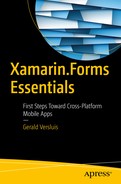And it’s a wrap! I hope you have enjoyed reading this book as much as I have enjoyed writing it. But before I leave you to start awesome projects on your own, I’d like to point out some other resources you can check out.
Besides writing books, I also have a blog, which covers basic things, but also not-so basic things. You can check it out at https://blog.verslu.is/ . And while I was writing blogs and the example code that comes with them, I thought to myself, “Why not start a screen recording while I am creating the sample code?”. So I got into some vlogging as well. These videos are actually in line with this book. I try to cover the most elemental concepts found in Xamarin.Forms, taking one subject at a time. If you’ve liked this book but need some more spoken instructions, you can go over to https://gur.codes and check it out. The videos are hosted on YouTube, it would be great if you’d subscribe there and like the videos. If you still have any questions, please comment on the videos or reach out to me some other way. This can be done through Twitter at https://twitter.com/jfversluis or e-mail via [email protected].
Another great resource for asking questions is StackOverflow (see https://stackoverflow.com ). I am pretty active there as well. Working with Xamarin gives you a great advantage when searching on StackOverflow and on the Internet as a whole. Because the traditional Xamarin code is a projection of its native counterparts—Objective-C/Swift and Java—most of the time, you can take some Objective-C code, paste it into a project, add some semicolons, and you’re good to go! There are many more relevant search results for you now that you can combine multiple programming languages.
There are also more formal ways to start learning Xamarin and Xamarin.Forms. There is an official Xamarin University. You can enroll in the university and follow live classes through the Internet. There are also some self-guided classes, but most of them are led by an instructor who is talking right then and there and available for questions. This is pretty awesome!
When you have chosen to learn with Xamarin University, you can also get certified. By following a special set of classes and passing a test, you can call yourself an official Xamarin Certified Developer.
Find more detail on this at https://www.xamarin.com/university .
Less official, but very good nonetheless, is the web site by Adam Pedley at https://xamarinhelp.com/ . His blog is full of all kinds of Xamarin-related posts and is read by thousands of people every day. The topics are very helpful and range from beginner to advanced developers. Recently, he introduced a paid video course, to be found at https://training.xamarinhelp.com/ . This is also a great resource to start after finishing this book. Not only will you get access to the video content, you will also be able to ask Adam questions directly on the Slack that he introduced for this. If something wasn’t clear in the video, you can ask him right there and share your experience with others.
Just before finishing this book, check out this great post by Xamarin, which also focuses on the Xamarin.Forms learning curve. You can read it at https://blog.xamarin.com/xamarin-forms-tips-beating-learning-curve/ .
Thank you very much for reading my book; I hope you found it useful!
